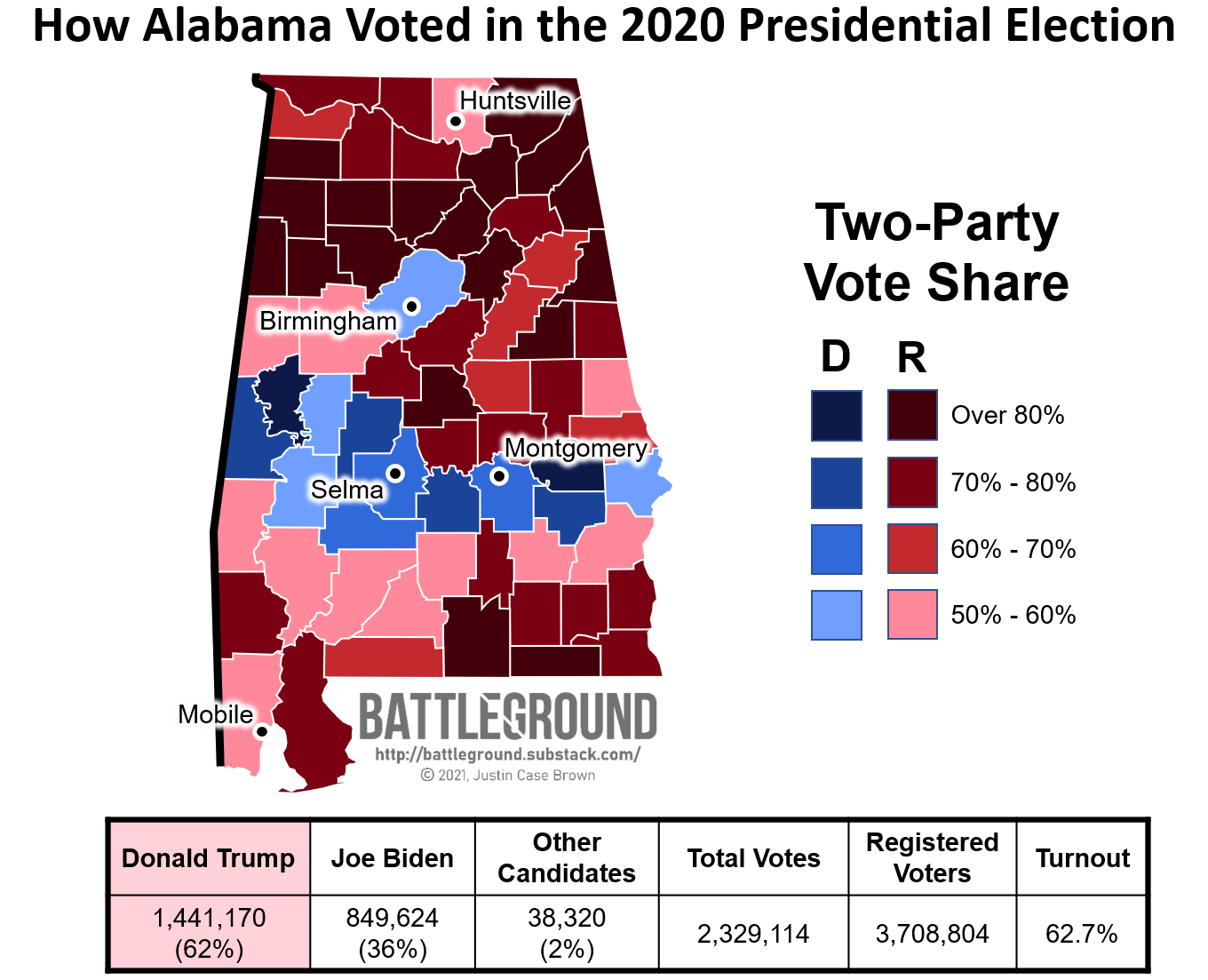Topline Takeaways
The legacy of slavery still shapes Alabama’s electoral geography and denotes a clear cultural divide in the state.
North Alabama can be considered “Trumpland” as counties in this region supported Trump by some of the largest margins in the nation.
Politicians can’t ignore voters’ high level of religious adherence. A majority of Alabama voters look to their religious beliefs to guide their political decisions.
In-depth Insights
Biden’s base of support slices through the middle of the state and splits Trump’s base into two halves. This contiguous band of blue counties is no accident or coincidence; it’s the legacy of slavery showing up in our electoral geography. This string of counties makes up the Alabama portion of the Black Belt.
If you read yesterday’s post on Mississippi, you’re already familiar with this term. For the uninitiated, this Booker T. Washington quote can help get you up to speed…
“I have often been asked to define the term ‘Black Belt.’ So far as I can learn, the term was first used to designate a part of the country which was distinguished by the color of the soil. The part of the country possessing this thick, dark, and naturally rich soil was, of course, the part of the South where the slaves were most profitable, and consequently they were taken there in the largest numbers. Later, and especially since the war [WWI], the term seems to be used wholly in a political sense – that is, to designate the counties where the black people outnumber the white.” – Booker T. Washington
For over a century the Black Belt has been a Democratic stronghold, enduring Republicans’ “Southern Strategy” and George Wallace’s 3rd party run in 1968. The fullest extent of this voting base was seen in the 2017 US Senate special election. The race was most known for the numerous sexual assault allegations levied against Roy Moore, overshadowing Doug Jones’ viewpoints on policy matters. Jones turned out to be a strong candidate due to his centrist views, some of which sat at odds with the left-wing of the national Democratic party. Throughout the campaign he was vocal about his support of the 2nd amendment, as well as his moderate views on abortion. These stances matched Alabama’s larger electorate and helped him become the first Democrat to represent the state in the US Senate since 1992.
Like much of the South, Alabama was a Democratic stronghold for most of the 20th century. Thanks to Republicans’ “Southern Strategy” employed in the 70s and 80s, Alabama has shifted to primarily supporting Republican candidates. This has culminated most recently in relentless support for Donald Trump, leading him to score the highest vote margin for a Republican presidential candidate since Barry Goldwater in 1964.
In my eyes, North Alabama is the geographic and cultural heart of Trumpland. With the Gulf Coast to its south, the Appalachian Mountains to its northeast and the Great Plains to its west, a sea of red counties extends in almost all directions outward from this area. Alabama’s 4th congressional district includes parts of North Alabama and is Trump’s highest scoring district in the nation, winning over 80% of the district’s voters in both 2016 and 2020. The neighboring 5th district is home to Mo Brooks, a fierce Trump loyalist that has served in Congress since 2011.
Due its geographic centrality, the area is a bit of a crossroads for different strains of Republican ideology. North Alabama holds the state’s fastest growing counties and leans on the pro-business Republicanism of the 1980s to attract heavy investment and spur growth. While this strategy has worked well for Republicans electorally, (counties in this area swung by as many as 30 points toward the party) the large influx of jobs has created a labor shortage that predates the pandemic.
The area is also a hotbed of social conservatism, powered by a strong adherence to religion. 86% of adults in the state identify as Christians and half of all Alabamians identify as Evangelical Protestants. When 77% of adults say that religion is “very important” in their lives, liberal ideas that push against conservative religious beliefs face heavy opposition.
Alabama is the only state where a majority of voters still oppose same-sex marriage. Opposition persists across racial lines when controlling for religious adherence; in a 2015 poll, 58% of Black evangelicals in Alabama opposed same-sex marriage while 75% of White evangelicals indicated opposition. 60% of Alabamians also oppose abortion under most circumstances and again, opposition is high among both Black and White evangelicals. Democrats’ difficulties in the state can be attributed to this incompatibility. Even when advocating for issues specific to the African American community, some Black voters choose to sit out on elections rather than vote for Democratic candidates that oppose conservative ideas.
Forecasting the Future: There’s not much indicating that Republican dominance in Alabama will change anytime soon. While Doug Jones’s candidacy provided hope for Alabama Democrats, his win was only possible due to a rare confluence of factors: he was a centrist candidate with deep roots within the state, faced a historically unpopular opponent, and mobilized an energized liberal voting base dissatisfied with Trump’s presidency. (And even after all of that, he only won the election by less than 2 points.) Republicans simply need to learn from this slip-up to keep the wins rolling in: ensure that candidates are truly electable (rather than engaging in self-inflicted controversies) and everything else should fall into place.






